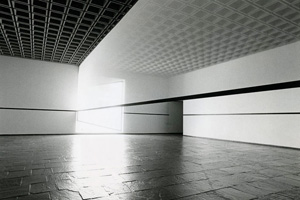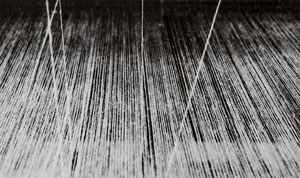Beyond American Art
John Haberin New York City
The Met Breuer and Nasreen Mohamedi
When Thomas P. Campbell spoke of restoring the Met Breuer to its "original purity and beauty," he was not knocking its former tenant, honest. Time takes its toll, even on a building as formidable as the Whitney's former home on Madison Avenue.
The Met did not remodel before moving in, its director explained. It did not twist the museum to its own ends. It merely acts as a proper caretaker, respecting a great architect's intentions. It even highlights them in the building's new name, after Marcel Breuer. And the Whitney's director, Adam D. Weinberg, agrees: the place has never looked better. 
Still, everything about it makes a statement about what only the Met can do, starting with its opening exhibitions. With Nasreen Mohamedi, it declares that a museum of American art like the Whitney cannot do justice to the world. With the choice of a woman, it may even get in its digs at MoMA's notoriously male roster. And with "Unfinished: Thoughts Left Visible" (to which I turn in a separate review), it throws its weight behind two full floors of selections, to argue that the puzzle of what counts as a work in progress did not begin with Modernism. Is it right? No doubt, but you may be too busy wallowing in an old friend and new acquaintances to care.
Mohamedi's retrospective feels like a private enclave, suiting a woman who wrote of creating art from solitude. The curators, Sheena Wagstaff with Roobina Karode of the Kiran Nadar Museum of Art in New Delhi and Manuel J. Borja-Villel of the Reina Sofia in Madrid, aim for spaces suitable to works on paper. The walls stake out a twisting path in a single dimension, like a confining maze, before opening up onto a space for further introspection, a reading room. There the great trapezoidal window does indeed add a new dimension to her simple but never symmetrical patterns, and so do the gridded alcoves of the high ceilings. Now and then the layout pauses for Mohamedi's diaries, with further drawings of their own. A full floor may not altogether suit her media, but it shows off the museum and follows the arc of her career.
Look familiar?
Campbell was addressing the press nearly three weeks before the formal opening of the Met Breuer in March 2016. With preview after preview, the Met is clearly putting on a show. In fact, it is inviting one to a party. The lobby gallery has a video by Prashant Bhargava, Radhe Radhe: Rites of Holi, of what might be a ritual, a riot, or a festival, with music by Vijay Iyer. At times the video, set in the mythic birthplace of Krishna, gives way to Iyer live in performance. As Campbell concluded his remarks, Iyer on piano accompanied a sax player, Mark Turner, in the style of late John Coltrane. Breuer's Brutalism may look to some like a bunker, and the entry crosses over what may look like a moat to keep people out, but come on in!
The Met has another case to make as well—although one that it chooses to forget in its anniversary celebration of "Making the Met." It declares, too, that it is fully engaged with the present, thank you, and not everyone agrees. Critics quickly piled on those opening shows. Two of three unfold in India, but the largest sticks to the Western canon. It is, the complaint ran, business as usual. Maybe, but anyone can say what he or she would do with the museum, given the unlikely chance, and the Met can only play to its strengths. And if one prefers a show of other media, other cultures, and other centuries, it has plenty of those back on Fifth Avenue.
Besides, the rest of us enter with a more pressing question: is this still the Whitney? Technically, yes. The Whitney has merely leased the building, which it cannot sell without losing a healthy chunk of its endowment, and it is not clear that it could find a buyer anyway. The Met has a real need for now, because it will be closing and renovating its modern wing, which has never done all that well by art, although critics like Ben Davis see darker motives. At least it is sparing New York another incursion into Central Park.
Better yet, the building feels like home. The lobby ceiling lights look familiar, and so does that dreadful red-clay sculpture in the stairwell by Charles Simonds, seemingly eroded by the sweat or maybe piss of visitors going back to 1966. A glorious trapezoidal window plays against the very shapes in drawings by Nasreen Mohamedi. The movable walls are still in action, giving her more confined spaces while opening up for "Unfinished"—in one case, not as a barrier but as paired partitions for the display of art. The museum will never, in truth, look as good as when the Whitney returned the second floor to Robert Irwin, for an installation that bared the architecture to its walls and its soul. Still, this will do.
Then again, the building does get more than a housecleaning. The firm of Beyer Blinder Belle has removed chewing gum, dirt, and unneeded cables, but not only that. The bookstore, which the Whitney used for a tremendous selection on artists and art theory, has migrated to the fifth floor, because (the story goes) Marcel Breuer intended only a lobby. A cafeteria lands up there, too. Besides, the Met has its own ideas of what to do with a lobby, including vending machines for tickets (should one wish to pay the full recommended admission) and information projected over the desk. As Campbell spoke from downstairs, his image appeared there for the overflowing press corps, twice over, like the corporate CEO that, necessarily, he is.
Does it matter that the Whitney had altered the fifth floor for good reason, to display its permanent collection, before moving to the new Whitney Museum downtown? Will the Met find a use for the basement and the moat? What will happen at the end of the lease, and what will happen along the way? Will the Met ever figure out that "purity" and "beauty" have contested meanings in modern and contemporary art? Can it do more than assert its brand name as the Met Breuer, much as the Cloisters has become the Met Cloisters—and what will happen to the building after it and the Frick Madison are gone? Come back in eight years and let me know.
Out of solitude
"One creates dimensions out of solitude." Nasreen Mohamedi was writing in her diary, sharing her thoughts with no one but herself. Elsewhere she did not shun company—whether as a student overseas at Central Saint Martins in London, a traveler in the Middle East, a long-time teacher in India, or one of its most prominent artists. She retired from Maharaja Sayajirao University in Baroda only in 1988, two years before her death. Yet her works never seem less than private, in pencil and ink barely visible to a distant eye. Often they seem to hold meanings for herself alone.
 Museums have been rediscovering women artists and parallels to Minimalism outside the United States—including Stefana McClure in Northern Ireland and London, Mono-ha and Gutai in Asia, and Monir Shahroudy Farmanfarmaian in Iran. Mohamedi has much in common as well with V. S. Gaitonde. Yet one can see her as working out of traditional forms and toward the West, even as she returns again and again to her family's beach house near Mumbai. Her art from the early 1960s has the greatest calligraphic impulse, with a felt-tip pen and with splashes of watercolor and ink. She studied printmaking in Paris, and she experiments with drypoint as well. These first works move freely between abstraction and a watery landscape, as if between worlds in art.
Museums have been rediscovering women artists and parallels to Minimalism outside the United States—including Stefana McClure in Northern Ireland and London, Mono-ha and Gutai in Asia, and Monir Shahroudy Farmanfarmaian in Iran. Mohamedi has much in common as well with V. S. Gaitonde. Yet one can see her as working out of traditional forms and toward the West, even as she returns again and again to her family's beach house near Mumbai. Her art from the early 1960s has the greatest calligraphic impulse, with a felt-tip pen and with splashes of watercolor and ink. She studied printmaking in Paris, and she experiments with drypoint as well. These first works move freely between abstraction and a watery landscape, as if between worlds in art.
She keeps experimenting, with lithographs and collage, but she also settles more firmly into Minimalism. By 1970, she reduces compositions to horizontal bands of black and gray. Two years later in New Delhi, lines tighten into a dense matrix set at angles to the page. Any art of repetition has to suggest Sol LeWitt, but Mohamedi is interested in neither algorithms nor visual confusion. Rather, she is using thin lines to clear away the black, like Richard Tuttle or Agnes Martin, broadening into the lightness of the page. For the rest of her short life, patterns grow in complexity while the work becomes sparer and sparer to the eye.
Around 1975, the lines veer into arcs, suspended in white space. They have the tense but floating geometry of El Lissitzky and Russian Constructivism. The sense of floating only grows with further experiments, first with photograms as part of Mumbai's Vision Exchange Workshop and then with cutouts. The first give rise to off-center triangles and trapezoids akin to that window. The second allows for negative spaces, with white lines on black. She might have been retreating into a dimension of her own.
She had every reason to do so. The changes in technique correspond to a progressive loss of motor control, and she died of Parkinson's disease in her early fifties. Yet she kept exhibiting to the end. For her, abstraction had the appeal of a shared vocabulary, in what another show featuring her has called "On Line," and shared tools, such as T-squares and rulers. "Concentration on tangent," she wrote to herself. "Curve."
Still, she had one further experiment that she kept to herself for nearly thirty years. All along she turned to photography, from the desert and sky of northern India to public benches, industrial silos, and a building by Le Corbusier. Like Ellsworth Kelly with his photographs, she was looking at her surroundings and abstracting away. "What geometry one finds on the beach," she wrote. One black form could pass for sculpture by Tony Smith, but with its mass torn away. Hers was a quiet art, maybe too quiet for the show's hundred and thirty works, but she was always drawing space.

The Met Breuer opened to the public on March 18, 2016. Vijay Iyer ran through March 31, Nasreen Mohamedi through June 5. A separate review takes up the remaining opening show, "Unfinished: Thoughts Left Visible."




